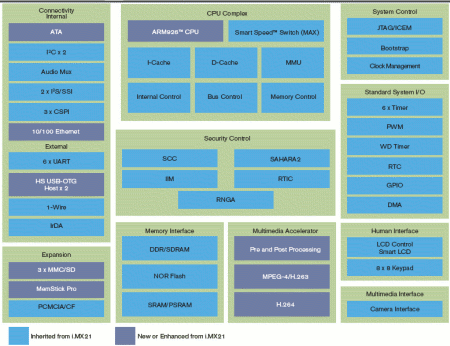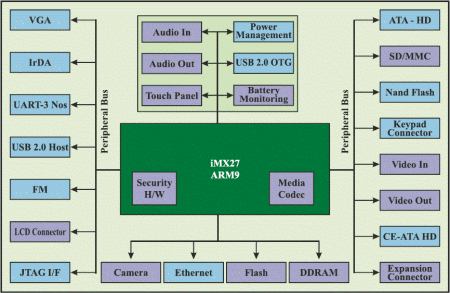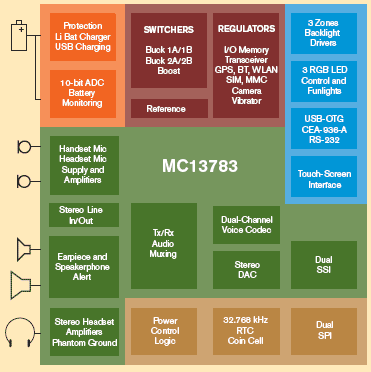Reference design targets video-centric Linux handhelds
Jan 12, 2007 — by LinuxDevices Staff — from the LinuxDevices Archive — 3 views A mobile device design specialist in Bangalore, India has announced one of the first hardware reference designs based on Freescale's currently-sampling i.MX27 processor. IWave's “iW-Rainbow-G3” design supports Linux 2.6, and targets video-centric mobile devices such as hard drive-equipped, D1-capable portable media… players.
A mobile device design specialist in Bangalore, India has announced one of the first hardware reference designs based on Freescale's currently-sampling i.MX27 processor. IWave's “iW-Rainbow-G3” design supports Linux 2.6, and targets video-centric mobile devices such as hard drive-equipped, D1-capable portable media… players.
(Click for larger view of iW-Rainbow-G3)
The G3 design appears to be iWave's third-generation Rainbow reference design for portable multimedia-enabled devices. Its earlier Rainbow designs included:
- The original Rainbow G1 design, based on an Intel PXA270 (Bulverde) processor
- An Rainbow G2 VoIP add-in card design based on a pair of FPGAs (field-programmable gate arrays)
IWave's Rainbow G3 design is among the first board-level IP (intellectual property) products based on Freescale's i.MX27 processor. Freescale announced the i.MX27 at its annual Technology Forum last summer, promising the chip would “move mobile applications toward high-definition (HD) quality video” with H.264 acceleration and a hard-drive interface.

iW-Rainbow-G3
(Click to enlarge)
Suggested applications for the Rainbow G3 design include medical PDAs, information kiosks, pollution monitoring devices, industrial PDAs, sports terminals, field force terminals, door phones, video-on-demand terminals, mobile TV, handheld multimedia players, video conferencing nodes, handheld data loggers, hand-held gaming devices, smartphones, and surveillance systems.
Freescale's i.MX27
The i.MX27 is a descendant of Freescale's venerable i.MX21 mobile applications processor, with which it shares many of its on-chip subsystems and peripheral interfaces. New in the i.MX27 is an “enhanced multimedia hardware accelerator” (eMMA) said to efficiently process MPEG4, H.263, and H.264 video streams at D1 resolution (DVD-quality, 720×480).

Freescale's i.MX27 adds to its earlier i.MX21 design
(Click to enlarge)
Other new i.MX27 features include:
- Enhanced ARM926 core
- ATA interface for consumer devices with hard drives
- USB OTG (on-the-go) interface for device-to-device connectivity without a PC
- Support for up to three SD/MMC cards
- A MemoryStick interface
The i.MX27 design targets clock rates of 400MHz at 1.6 Volts, or 266MHz at 1.2 Volts. The system bus runs at 133MHz. Fabbed on 90nm process tech, and delivered in a 404-ball MAPBGA, it measures 0.67 inches (17mm) square.
IWave's Rainbow G3 design
IWave's i.MX27-based iW-Rainbow-G3 design measures 3.3 inches (85 mm) square. It has 64MB of RAM, and 128MB of flash memory, expandable through a plethora of storage interfaces.

iWave's Rainbow 3G design
(Click to enlarge)
The iWave design also uses Freescale's MC13783 power management companion chip, Freescale confirms.

MC13783 power management chip
Additional touted Rainbow G3 features include:
- SVGA (800×600) LCD touchscreen interface
- VGA interface
- Keypad interface
- Wireless connectivity:
- USB WLAN
- SDIO WLAN
- IrDA
- I/O
- USB 2.0 host
- USB 2.0 OTG
- Serial port
- 3 x UARTs
- Ethernet
- Audio I/O
- Storage/expansion
- SD/MMC interface
- ATA HD
- CE-ATA HD
- NAND flash interface — up to 1GB supported
- FM radio
- CMOS camera
- Battery
IWave says drivers are available for all peripherals on its Rainbow G3 design. Supported embedded operating systems include Linux 2.6.18 and Windows CE 6.0, according to the company.
Mohamed Saliya, iWave managing director, stated, “Be ready to head start your hi-tech products.”
Availability
The Rainbow G3 design, like Freescale's i.MX27, appears to be sampling. Pricing was not disclosed.
This article was originally published on LinuxDevices.com and has been donated to the open source community by QuinStreet Inc. Please visit LinuxToday.com for up-to-date news and articles about Linux and open source.